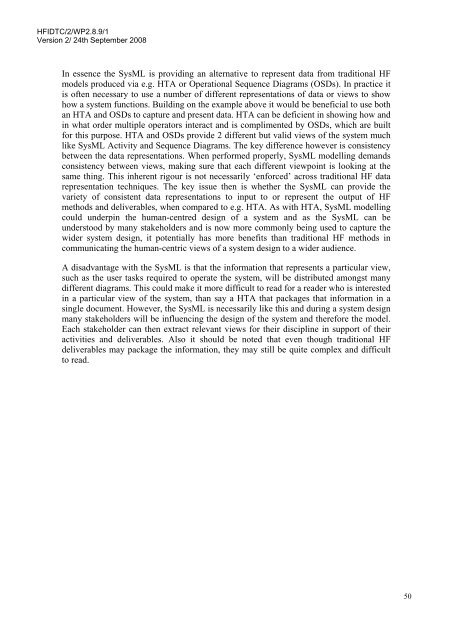Modelling Human Factors using the Systems Modelling Language
Modelling Human Factors using the Systems Modelling Language
Modelling Human Factors using the Systems Modelling Language
Create successful ePaper yourself
Turn your PDF publications into a flip-book with our unique Google optimized e-Paper software.
HFIDTC/2/WP2.8.9/1Version 2/ 24th September 2008In essence <strong>the</strong> SysML is providing an alternative to represent data from traditional HFmodels produced via e.g. HTA or Operational Sequence Diagrams (OSDs). In practice itis often necessary to use a number of different representations of data or views to showhow a system functions. Building on <strong>the</strong> example above it would be beneficial to use bothan HTA and OSDs to capture and present data. HTA can be deficient in showing how andin what order multiple operators interact and is complimented by OSDs, which are builtfor this purpose. HTA and OSDs provide 2 different but valid views of <strong>the</strong> system muchlike SysML Activity and Sequence Diagrams. The key difference however is consistencybetween <strong>the</strong> data representations. When performed properly, SysML modelling demandsconsistency between views, making sure that each different viewpoint is looking at <strong>the</strong>same thing. This inherent rigour is not necessarily ‘enforced’ across traditional HF datarepresentation techniques. The key issue <strong>the</strong>n is whe<strong>the</strong>r <strong>the</strong> SysML can provide <strong>the</strong>variety of consistent data representations to input to or represent <strong>the</strong> output of HFmethods and deliverables, when compared to e.g. HTA. As with HTA, SysML modellingcould underpin <strong>the</strong> human-centred design of a system and as <strong>the</strong> SysML can beunderstood by many stakeholders and is now more commonly being used to capture <strong>the</strong>wider system design, it potentially has more benefits than traditional HF methods incommunicating <strong>the</strong> human-centric views of a system design to a wider audience.A disadvantage with <strong>the</strong> SysML is that <strong>the</strong> information that represents a particular view,such as <strong>the</strong> user tasks required to operate <strong>the</strong> system, will be distributed amongst manydifferent diagrams. This could make it more difficult to read for a reader who is interestedin a particular view of <strong>the</strong> system, than say a HTA that packages that information in asingle document. However, <strong>the</strong> SysML is necessarily like this and during a system designmany stakeholders will be influencing <strong>the</strong> design of <strong>the</strong> system and <strong>the</strong>refore <strong>the</strong> model.Each stakeholder can <strong>the</strong>n extract relevant views for <strong>the</strong>ir discipline in support of <strong>the</strong>iractivities and deliverables. Also it should be noted that even though traditional HFdeliverables may package <strong>the</strong> information, <strong>the</strong>y may still be quite complex and difficultto read.50
















